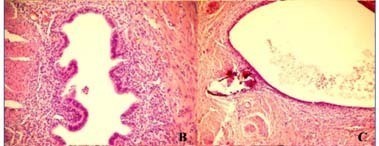Revista Brasileira de Ginecologia e Obstetrícia. 2007;29(11):568-574

PURPOSE: to evaluate the histological differentiation pattern in superficial peritoneum lesions and in deeply infiltrating endometriosis (DIE) in utero-sacral ligament, bowel (rectum and sigmoid colon) and rectovaginal septum. METHODS: this prospective non-randomized study included 139 patients. Of the total, 234 biopsies were obtained (179 with DIE – Deeply Group – and 55 superficial endometriosis – Superficial Group). From the 179 DIE lesions (Depply Group), 15 were obtained from rectovaginal septum, 72 from rectosigmoid nodules and 92 from utero-sacral ligament. Biopsies were classified in well-differentiated glandular pattern, undifferentiated glandular, mixed glandular differentiation and pure stromal disease, based on specific morphological classification. RESULTS: in the Depply Group (DIE), 33.5% of the biopsies showed undifferentiated glandular pattern and 46.9% mixed glandular pattern. In the Superficial Group, there was the predominance of the well-differentiated glandular pattern (41.8%). Comparing specifically the different localizations of the biopsies of DIE lesions (Deeply Group), a predominance of mixed pattern in bowel nodules (61.1%) was noted. CONCLUSIONS: it was possible to conclude that there is a predominance of well-differentiated glandular pattern in superficial endometriosis, a predominance of mixed undifferentiated in deeply pelvic endometriosis and, specifically studying endometriosis from the rectum and sigmoid colon, there was a predominance of the mixed pattern.
Search
Search in:


Comments